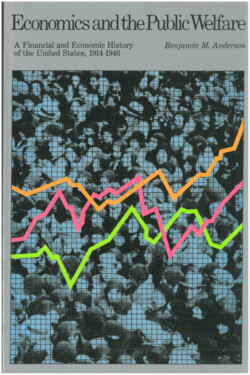Читать книгу Economics and the Public Welfare - Benjamin M. Anderson - Страница 20
На сайте Литреса книга снята с продажи.
Оглавление[print edition page 92]
10
The Government’s Contribution to the Revival, 1921-23
No Deficit Financing—Overbalanced Budgets Every Year. From the standpoint of New Deal economics, the United States government in the period 1920-23 was extremely benighted. The idea that an unbalanced budget with vast pump-priming government expenditure is a necessary means of getting out of a depression received no consideration at all. It was not regarded as the function of the government to provide money to make business activity. It was rather the business of the United States Treasury to look after the solvency of the government, and the most important relief that the government felt that it could afford to business was to reduce as much as possible the amount of government expenditure, which had risen to great heights during the war; to reduce taxes—but not much; and to reduce public debt. Government expenditures ran as follows during these years:
UNITED STATES GOVERNMENT EXPENDITURES (NOT INCLUDING PUBLIC DEBT RETIREMENT)
(In millions of dollars)
| Fiscal year 1920 | 6,403 |
| Fiscal year 1921 | 5,116 |
| Fiscal year 1922 | 3,373 |
| Fiscal year 1923 | 3,295 |
Taxes ran as follows during these years:
ORDINARY RECEIPTS OF THE UNITED STATES GOVERNMENT
(In millions of dollars)
| Fiscal year 1920 | 6,695 |
| Fiscal year 1921 | 5,625 |
| Fiscal year 1922 | 4,109 |
| Fiscal year 1923 | 4,007 |
[print edition page 93]
The public debt was rapidly reduced as the following figures show:
UNITED STATES GOVERNMENT DEBT
(In millions of dollars)
| June 30 | |
| 1920 | 24,298 |
| 1921 | 23,976 |
| 1922 | 22,964 |
| 1923 | 22,350 |
Rapid Reduction of Army, Navy, and Civil Service. Nor did the government increase public employment with a view to taking up idle labor. There was reduction in the army and navy in the course of these years, and there was a steady decline in the number of civilian employees of the federal government.
Sound Government Financial and Monetary Policy Generates Business Confidence. This policy on the part of the government generated, of course, a great confidence in the credit of the government, and the strength of the gold dollar was taken for granted. The credit of the government and confidence in the currency are basic foundations for general business confidence. The relief to business through reduced taxes was extremely helpful.
Great Spurt in New Technology, 1921-23. One major factor in the extraordinarily strong business revival of 1921-23 was a great spurt in the application of new technology to industry. During the war and the postwar boom, our industrial system had been overstrained by the heavy demands made upon it. Management, harassed by rush orders, did not have time to make far-reaching plans or to keep pace with the growth of technological knowledge. Our increased production during the war and the postwar boom was much more a matter of increasing the number of wage earners than of increasing the efficiency per man through new technology, through growing skill of labor, and through improved managerial policies.
In the depression of 1921 management had time once more to study new methods and to make long-run plans. Overtime work ceased, shop discipline improved, and men valued their jobs. A great body of new technological ideas was awaiting application. Many of these ideas had been developed as part of the technology of war in the fields of aircraft, artillery, naval construction, fortifications, and the chemistry of explosives. But the same ideas, with modifications, were to have fruitful application to peacetime pursuits. They were waiting to be used. In the years 1921-23 there was widespread application of the improved technology. The following table reveals the facts:
[print edition page 94]
GROWTH OF MANUFACTURING PRODUCTION IN THE UNITED STATES, 1914-23*
Index Numbers of Physical Volume of Production, Number of Wage Earners, and per Capita Output
| Year | Physical volume of production | Number of wage earners | Output per wage earner |
| 1914 | 100.0 | 100.0 | 100.0 |
| 1919 | 127.7 | 124.5 | 102.6 |
| 1921 | 105.7 | 100.1 | 105.6 |
| 1923 | 156.3 | 130.3 | 120.0 |
* Frederick C. Mills, Economic Tendencies in the United States (New York, 1932), p. 192.
From 1914 to 1919 physical output per wage earner in manufacturing increased only 2.6 percent. From 1921 to 1923 output per wage earner increased 14.4 percent. If those who fear technological improvement were right, then this should have been accompanied by a falling off in the number of workers in manufacturing. It was, however, as shown by our table, accompanied by an increase of 30 percent in the number of wage earners. Rapidly improving technology did not make unemployment. Rather, it helped to generate an immense increase in employment. Production itself generates purchasing power, and therefore creates employment. Production in one place gives rise to demand for production in other places. Be it observed, moreover, that this rapid spurt in technological progress comes, not at the end of the great boom, 1921-29, but, rather, at the beginning of this great boom.
